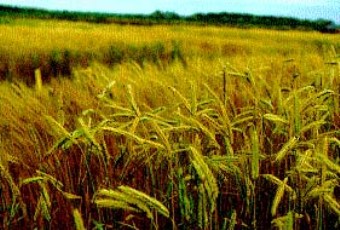My Friends and Enemies (Interactions)
WHAT KIND OF RELATIONSHIPS DOES THIS ORGANISM EXHIBIT?
Claviceps purpurea has a TON of different relationships with a
number of different species! We'll take a look at a number of
different ways that this organism shows relationships with other
organisms.
PARASITE
As we know, ergot is an obligate parasite on open-pollinated
grasses such as rye,
barley and wheat. It does NOT infect
corn,
Zea mays, like many people believe. If you do find something
purple growing on your corn, it is probably corn smut. The
reason that Claviceps purpurea is considered a parasite on these
plants is because it steals the nutrients from the plant and is
harming it in some way without doing anything in exchange for
the nutrients. There are also some scientists, however, that consider this a mutualistic relationship (see more below). This
parasitic relationship also has dire human effects in a couple of
different ways. One way that it is bad is that it can kill crops and
lead to a lower crop yield. It also can have dire effects on
livestock (see more below). Well, what if you're not a farmer and
you don't really care about crop yield and cows? Well, ergot is also
a human pathogen, causing two different strains of ergotism in
humans who ingest it.
growing on your corn, it is probably corn smut. The
reason that Claviceps purpurea is considered a parasite on these
plants is because it steals the nutrients from the plant and is
harming it in some way without doing anything in exchange for
the nutrients. There are also some scientists, however, that consider this a mutualistic relationship (see more below). This
parasitic relationship also has dire human effects in a couple of
different ways. One way that it is bad is that it can kill crops and
lead to a lower crop yield. It also can have dire effects on
livestock (see more below). Well, what if you're not a farmer and
you don't really care about crop yield and cows? Well, ergot is also
a human pathogen, causing two different strains of ergotism in
humans who ingest it.
MUTUALIST
 Ergot is by some considered to have a mutualistic relationship
with the plants it infects because in exchange for the nutrients
that it takes, it provides protection for the plant from being
eaten by insects and other animals. In other words, both organisms are getting some sort of
benefit from this relationship. This is because after an insect
or
animal, like a
cow,
deer,
horse,
sheep or even a cute
birdie eats the fungus, they will get sick from the ergot
alkaloids. These chemicals produced by Claviceps purpurea give
the animals ergotism. Animals can exhibit a number of different symptoms
based on the specific strain of ergot that they consume, how
often they eat it, climatic conditions under which
the ergot
Ergot is by some considered to have a mutualistic relationship
with the plants it infects because in exchange for the nutrients
that it takes, it provides protection for the plant from being
eaten by insects and other animals. In other words, both organisms are getting some sort of
benefit from this relationship. This is because after an insect
or
animal, like a
cow,
deer,
horse,
sheep or even a cute
birdie eats the fungus, they will get sick from the ergot
alkaloids. These chemicals produced by Claviceps purpurea give
the animals ergotism. Animals can exhibit a number of different symptoms
based on the specific strain of ergot that they consume, how
often they eat it, climatic conditions under which
the ergot grew, and the variations of alkaloid content. Symptoms ranging
from
backwards arching of the back, laying down,
hyper-excitability, staggering and convulsions. It can also cause spontaneous abortions and gangrenous ergotism, which makes the
hind limbs of the animal fall off! Clearly, this does not sound like an enjoyable experience for the
animal and after this, they can smell the ergot and then
avoid eating plants that are infected. To learn more about another fungal mutualism, check out this page on
lichens!
grew, and the variations of alkaloid content. Symptoms ranging
from
backwards arching of the back, laying down,
hyper-excitability, staggering and convulsions. It can also cause spontaneous abortions and gangrenous ergotism, which makes the
hind limbs of the animal fall off! Clearly, this does not sound like an enjoyable experience for the
animal and after this, they can smell the ergot and then
avoid eating plants that are infected. To learn more about another fungal mutualism, check out this page on
lichens!
Commensalism
Interactions with insects is an extremely important part of the
 ergot lifecycle and success. For the best dispersal, insects like butterflies and
bees are needed as vectors to
take the spores from one plant to another. The reason that this
is considered a commensalism is because one
organism (ergot) is gaining something by using another organism
(the insect) without harming it.
ergot lifecycle and success. For the best dispersal, insects like butterflies and
bees are needed as vectors to
take the spores from one plant to another. The reason that this
is considered a commensalism is because one
organism (ergot) is gaining something by using another organism
(the insect) without harming it.
To learn more about how this fungus has been used medicinally, check out MEDICINAL USES! Or else, you can always go HOME.